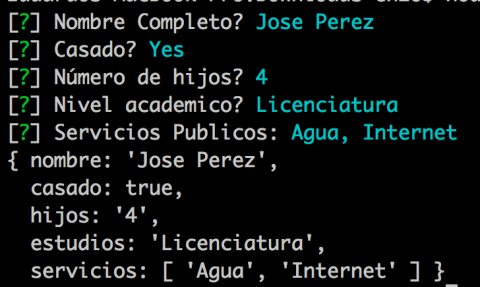One of the first things we learn in a new programming language is how to implement a command line is to read the parameters provided by the user in execution, today I want to make my first blog related to Node.js, and I will show you how to make an interactive interface with Node.js.
For those who are unfamiliar with the concept of interactive interfaces may refer to popular NCurses used in GNU/Linux platforms.
Install Inquirer plugin.
Assuming you already installed Node.js, we will use npm command to install the plugin inquirer to provide us an easy way to creating an interface.
$ npm install inquirerCreate interactive script
With the Inquirer plugin installed, we need to create a script called interactivo.js in which we will create our script.
The first thing to do is load the library inquirer as shown below.
var inquirer = require("inquirer");To use Inquirer we just pass an array of objects with questions and an anonymous function that will process the responses received, let me show an example the format of implementation.
inquirer.prompt([/* Pass your questions in here */],
function( answers ) {
// Use user feedback for... whatever!!
});Now let’s see the types of questions that we can build.
Input
Input type questions are simple questions that can have a default value, and the response is stored in a variable equal to the name that is provided in the configuration, sees the implementation.
{
type: 'input',
name: 'nombre',
message: 'Nombre Completo?',
default: 'Jose Perez'
},Confirm
The confirm questions are of the type Yes or NO let’s see an example of its implementation.
{ type: 'confirm',
name: 'casado',
message: 'Casado?',
},List
The list questions allow you to select your answer from a list of predefined options, as shown below.
{
type: "list",
name: "estudios",
message: "Nivel academico?",
choices: [
"Primaria",
"Secundaria",
new inquirer.Separator(),
"Bachillerato",
"Licenciatura",
"Doctorado"
]
},This type of question allows placing a separator of options as is seen in the above list.
Checkbox
The checkbox questions type allows the user to check a list of options which apply in his case, as shown in the following code listing.
{
type: "checkbox",
message: "Servicios Publicos",
name: "servicios",
choices: [
{
name: "Agua",
checked: true
},
{
name: "Luz"
},
{
name: "Internet"
},
],
}Password
The password questions type as its name suggest use a mask to hide what the user is typing on the screen, let’s see an example.
{
type: "password",
message: "Enter your git password",
name: "password"
}Let’s now look full implementation.
var inquirer = require("inquirer");
var preguntas = [
{
type: 'input',
name: 'nombre',
message: 'Nombre Completo?',
default: 'Jose Perez'
},
{ type: 'confirm',
name: 'casado',
message: 'Casado?',
},
{ when: function (response) {
return response.casado;
},
type: 'input',
name: 'hijos',
message: 'Número de hijos?',
},
{
type: "list",
name: "estudios",
message: "Nivel academico?",
choices: [
"Primaria",
"Secundaria",
new inquirer.Separator(),
"Bachillerato",
"Licenciatura",
"Doctorado"
]
},
{
type: "checkbox",
message: "Servicios Publicos",
name: "servicios",
choices: [
{
name: "Agua",
checked: true
},
{
name: "Luz"
},
{
name: "Internet"
},
],
}
];
inquirer.prompt(preguntas, function(respuestas) {
console.log(respuestas);
});As you can see what I did was create an array of objects with the definitions of the types of questions outlined above and this arrangement is passed to the inquirer.prompt function and as the second parameter, an anonymous function is a pass to prints the user’s responses.
Within the definition of the questions, the script adds a bonus which is the use of when property. When is a property that allows us to validate if we show or not a question confirming the previous answers as is shown below
when: function (response) {
return response.casado;
}Execute the script.
To run the newly created script we just run the following command line.
$ node interactivo.jsDepending on user responses the result will be different, but similar to the following image.

I hope you have found this blog useful.